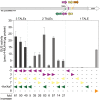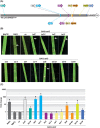Dissection of TALE-dependent gene activation reveals that they induce transcription cooperatively and in both orientations
- PMID: 28301511
- PMCID: PMC5354296
- DOI: 10.1371/journal.pone.0173580
Dissection of TALE-dependent gene activation reveals that they induce transcription cooperatively and in both orientations
Erratum in
-
Correction: Dissection of TALE-dependent gene activation reveals that they induce transcription cooperatively and in both orientations.PLoS One. 2017 Apr 6;12(4):e0175653. doi: 10.1371/journal.pone.0175653. eCollection 2017. PLoS One. 2017. PMID: 28384283 Free PMC article.
Abstract
Plant-pathogenic Xanthomonas bacteria inject transcription activator-like effector proteins (TALEs) into host cells to specifically induce transcription of plant genes and enhance susceptibility. Although the DNA-binding mode is well-understood it is still ambiguous how TALEs initiate transcription and whether additional promoter elements are needed to support this. To systematically dissect prerequisites for transcriptional initiation the activity of one TALE was compared on different synthetic Bs4 promoter fragments. In addition, a large collection of artificial TALEs spanning the OsSWEET14 promoter was compared. We show that the presence of a TALE alone is not sufficient to initiate transcription suggesting the requirement of additional supporting promoter elements. At the OsSWEET14 promoter TALEs can initiate transcription from various positions, in a synergistic manner of multiple TALEs binding in parallel to the promoter, and even by binding in reverse orientation. TALEs are known to shift the transcriptional start site, but our data show that this shift depends on the individual position of a TALE within a promoter context. Our results implicate that TALEs function like classical enhancer-binding proteins and initiate transcription in both orientations which has consequences for in planta target gene prediction and design of artificial activators.
Conflict of interest statement
Figures







Similar articles
-
The genetic arms race between plant and Xanthomonas: lessons learned from TALE biology.Sci China Life Sci. 2021 Jan;64(1):51-65. doi: 10.1007/s11427-020-1699-4. Epub 2020 Jul 10. Sci China Life Sci. 2021. PMID: 32661897 Review.
-
Consequences of adaptation of TAL effectors on host susceptibility to Xanthomonas.PLoS Genet. 2021 Jan 19;17(1):e1009310. doi: 10.1371/journal.pgen.1009310. eCollection 2021 Jan. PLoS Genet. 2021. PMID: 33465093 Free PMC article.
-
An engineered promoter driving expression of a microbial avirulence gene confers recognition of TAL effectors and reduces growth of diverse Xanthomonas strains in citrus.Mol Plant Pathol. 2017 Sep;18(7):976-989. doi: 10.1111/mpp.12454. Epub 2016 Sep 7. Mol Plant Pathol. 2017. PMID: 27362693 Free PMC article.
-
A promoter trap in transgenic citrus mediates recognition of a broad spectrum of Xanthomonas citri pv. citri TALEs, including in planta-evolved derivatives.Plant Biotechnol J. 2023 Oct;21(10):2019-2032. doi: 10.1111/pbi.14109. Epub 2023 Jul 8. Plant Biotechnol J. 2023. PMID: 37421233 Free PMC article.
-
TALEs as double-edged swords in plant-pathogen interactions: Progress, challenges, and perspectives.Plant Commun. 2022 May 9;3(3):100318. doi: 10.1016/j.xplc.2022.100318. Epub 2022 Mar 25. Plant Commun. 2022. PMID: 35576155 Free PMC article. Review.
Cited by
-
Assembling highly repetitive Xanthomonas TALomes using Oxford Nanopore sequencing.BMC Genomics. 2023 Mar 27;24(1):151. doi: 10.1186/s12864-023-09228-1. BMC Genomics. 2023. PMID: 36973643 Free PMC article.
-
The genetic arms race between plant and Xanthomonas: lessons learned from TALE biology.Sci China Life Sci. 2021 Jan;64(1):51-65. doi: 10.1007/s11427-020-1699-4. Epub 2020 Jul 10. Sci China Life Sci. 2021. PMID: 32661897 Review.
-
Complete Genome Assemblies of All Xanthomonas translucens Pathotype Strains Reveal Three Genetically Distinct Clades.Front Microbiol. 2022 Mar 2;12:817815. doi: 10.3389/fmicb.2021.817815. eCollection 2021. Front Microbiol. 2022. PMID: 35310401 Free PMC article.
-
The Rice ILI2 Locus Is a Bidirectional Target of the African Xanthomonas oryzae pv. oryzae Major Transcription Activator-like Effector TalC but Does Not Contribute to Disease Susceptibility.Int J Mol Sci. 2022 May 16;23(10):5559. doi: 10.3390/ijms23105559. Int J Mol Sci. 2022. PMID: 35628368 Free PMC article.
-
Proteomic analysis reveals dynamic expression related to malondialdehyde in cassava in response to cassava bacterial blight.Sci Rep. 2025 Jul 9;15(1):24670. doi: 10.1038/s41598-025-10051-9. Sci Rep. 2025. PMID: 40634452 Free PMC article.
References
-
- Boch J, Bonas U, Lahaye T. TAL effectors—pathogen strategies and plant resistance engineering. New Phytol. 2014;204: 823–832. - PubMed
MeSH terms
Substances
LinkOut - more resources
Full Text Sources
Other Literature Sources

